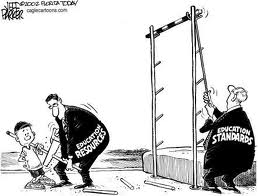
Ed. "reformers" look for results. Where they fail, however, is they turn a blind eye to how those results were achieved and, ultimately, whether those results are valid or not.
In the Bloomberg era, under threat of being closed, schools had to become extra crafty to survive. Graduation rates increased but at the expense of some academically-devoid credit-recovery schemes.
The NY Daily News has covered this story as well. In 2012, nine schools awarded one out of every ten credits as credit recovery. The 2012 City graduation rate was bumped up 2% through credit recovery. At some schools, one in four credits were awarded through credit recovery schemes from 2011-2012. You can find numerous comments online where teachers discuss how credit recovery worked at their schools. (See "What has credit recovery looked like in your school?")
These schemes were practiced throughout the City. If students know there is an easier alternative, many will not care to devote time to their regularly scheduled classes. Yet, the administrative pressure, stated both directly and indirectly, remains to pass students.
Regents tests, funded by our previous Mayor, seemed to become easier for a time. Cut scores were set by a more generous hand. According to Dr. Ravitch:
"The New York State Regents exams were made significantly easier over the past dozen years especially in terms of the grading scale applied to the exams. Math is an illustrative example. The Sequential Math 1 exam required the test taker to earn 65 percent of the available points to receive a passing score. The Math A exam, which replaced Sequential 1 in June 2002, required the test taker to earn 43 percent of the available points to receive a passing score. The Integrated Algebra exam, which replaced the Math A exam in 2009, requires the test taker to earn only 34.5 percent of the available points to receive a passing score. [19] Additionally the Biology exam was replaced by the Living Environment exam in 2001 and the Global Studies exam by the Global History exam in 2000. In each case the newer version was less content driven. [20]An academic study looking at changes in scoring and in difficulty of the Regents exams over the past 15 or so years would fill a gaping hole in our ability to make sense of test trends."
Simultaneously more pressure and funding were put towards test preparation. Teachers became constrained. Uniformity prevailed. Funding dried up for so many non-test-related aspects of school life, so very critical to human existence.
Mayor Bloomberg plans to save education also included running once thriving schools into the ground at record speed (see DeWitt Clinton High School also). Murray Bergtraum, once a flourishing school community, was flooded with low-performing students. It was put on a crash course to closure, reinforcing the ideas that public schools fail and paving the way for more privately-run charters.
"At Bergtraum, the DOE has shoveled in more low-performing students with nowhere to go after the closure of other big schools, such as Martin Luther King on the Upper West Side, Seward Park on the Lower East Side and Park West in Hell’s Kitchen, staffers say.
“'We were the dumping ground,” Elfrank-Dana said. “That was the beginning of the end.'”
Some charters may have data which seems beautiful--if it blinds you to underlying causes. Some are selective in their admissions. Some fail to take kids with the highest needs. Let us also remember how high attrition rates and, in the case of Geoffrey Canada, the expulsion of two cohorts, can make data appear pristine. Failing students have not been taught how to succeed. Instead, it seems they have been shown the door. This seems to be the secret sauce when schools with "tenureless," unprotected teachers boast of their Success.
So, yes, I would like to know De Blasio's plans. But I would also beg to remind Mr. Flanagan that Bloomberg's formula for success was anything but that. Before we press De Blasio for a magic formula, let's reassess what didn't work. Diane Ravitch explains the Bloomberg "miracle" well::
Conclusions: there was no New York City miracle. Judging school quality by graduation rates encourages credit recovery and fraud. What’s needed most now is a Truth Commission to sweep away false claims and to establish a record unsullied by boasting and pretense. It is not likely to happen, unfortunately, given that the de Blasio administration wants to ease quietly into a new and better world, without publicly airing the dirty laundry left behind. More revelations like this one, however, and the truth will out.
We need to make sure that schools don't succeed by dismissing kids prior to test day. Let's "Remember the El Paso!" In this particular instance, in the name of painting a picture or success, El Paso witnessed a scandal of disappearing students.
Reform will never service society until we start thinking less about gaming data, privatizing and making profits. We need to think more about the real kids who need the most help, the ones who have been given the shuffle. And we need to make sure, we help these same kids.
No comments:
Post a Comment